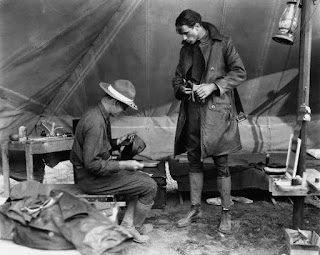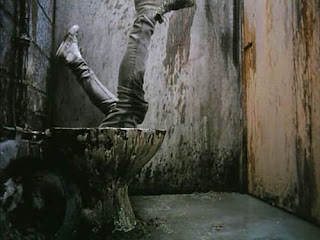Dir. Fede Alvarez
It's Halloween season! Time to break out the horror films. I can't say I'm massively well-versed in the genre, but I do enjoy them if they're done well. I'm missing a lot of the classics like Friday the 13th and the original Dawn of the Dead, but I've caught up lately on the Nightmare on Elm Street films, and I've seen quite a few classics like The Exorcist and The Thing; and the even more vintage Universal monster flicks such as Creature from the Black Lagoon, The Mummy, and Dracula. Honestly, as long as there aren't a bunch of cheap jump-scares, I'll probably enjoy it.
The Evil Dead series has never been serious horror. The first film, released back in 1981, is a lovely bit of cheap-horror that has since solidified the 'teens-in-the-cabin-in-the-woods' mythology of horror, as satirized in, well, Cabin in the Woods. It's not scary-per-se, in fact, a lot of the makeup looks a bit goofy these days, but it's clearly structured like a straight horror film, with a little levity in the dialogue. The second quickly re-caps the plot of the first film before descending (or should that be ascending?) into the best wacky comedy-horror put to film. Army of Darkness is pretty much an action-comedy that just happens to continue from the second film. My point is, the Evil Dead franchise is less about frightening you, and more about having a fun time, it just so happens to involve demonic possession, a rape-tree, and a lot of blood.
The 2013 remake, as far as I'm concerned, is one of the best horror films of the last five years. Now now, don't get me wrong, it doesn't hold a candle to It Follows or The Babadook for actual fright/creep factor, but as we've established, Evil Dead has never been about that. But within the horror genre, it's so damn fun. It's gross, cringe-inducing, funny, and more than anything, visceral. You feel what the characters go though, with every single one taking a hell of a beating, and each one deserving any victory they get. It's remarkably well-shot, well-produced (the cabin is gorgeously constructed), and of course, has great CG/make-up work when everything gets a bit stabby. The only possible mark-down I can give it is a little bit of pacing issues, not the best sign for a 90 minute film, but it is such a bare-bones story in the first place that I cut it some slack. By all other criteria, Evil Dead (2013) is a fine film.
So - doors. The demonic entity awoken by Eric (Lou Taylor Pucci) primarily takes influence by possessing Mia (Jane Levy) and spreading from there. However, I noticed that the only other physical influence it has, beyond spreading biologically through vomit or blood, is by slamming doors shut. It's actually impressive how much it achieves by shutting a few doors. The obvious to note here is the trap-door leading to the Necronomicon book in the basement, which contains the words to awake the demon. This trap-door is pretty iconic for the shot in the first picture, also present in the original film. Mia is thrown into the basement, the trap door shutting her in.
After Olivia (Jessica Lucas) is infected, becomes possessed, and begins to move towards Eric in the bathroom to kill him, what does the demon do? It shuts the door. It's making sure that no-one will interrupt the murder, and stopping Eric from getting away. Functionally it also remind us of the power it holds. Later, Natalie (Elizabeth Blackmore) sees the trap-door suddenly open, and hears Mia crying, luring her to enter the basement. The demon is clearly having fun with the slow-burn of killing these teenagers, as it has the power to open the trap-door at any time. It relinquishes Mia, having her give an honest performance of fear and confusion, leading Natalie into her domain.
The box-cutter scene happens, and yes, it's gross in all the best ways. After Natalie is rescued from the possessed Mia, David (Shiloh Fernandez) chains it shut. The demons toys with this as it pokes it's head up through the gap in the trap-door, taunting Natalie as she resits infection. Doors then, particularly the trap-door, are important set-ups for different power-struggles between the teens and the demon.
Later into the film, as David returns to get the keys so that he and the now, demon-free Mia can leave, he is critically wounded by the dead Eric, who he forgot was still in the house and open to possession. What's important however, is that David is now the one who has the power, as he shuts the door, locking Mia out of the house, so that he can now shoot a gasoline can, killing himself, Eric, and burning the cabin. After this then, there is no upper-hand between demon and human. There are no more doors to toy with on either side. The Abomination admittedly is stronger than the regular undead, however Mia evens the score with a chainsaw, and eventually wins out.
Actually, now I think about it, I could mention the car door of the Jeep. The classic horror-trope of reaching for the keys on the floor, sudden enemy in the window, attack on the the driver does happen here. So that's score-one for demon when it comes to doors. The car is tipped over, crushing Mia's hand and pinning it to the floor, under the door. She struggles, boy does she struggle, tearing her arm away from her hand, giving her the advantage of reaching the chainsaw; (Also, calling back to the original films in an original way, good-going Alvarez!), score-one (and match) to Mia for escaping the hold of the door and being able to end the demon.
It's basic story-telling at the end of the day I suppose. What do doors do? They stop people from leaving rooms, they are an antagonist in the most basic sense, but when possessed by a demon, they're definitely an antagonist. Why demons don't just possess guns or knives instead of wooden doors I don't know! Actually, yes I do, because that wouldn't be fun, and if there's anything Evil Dead is, it's fun.









































